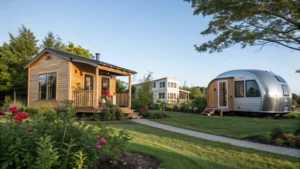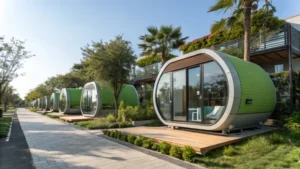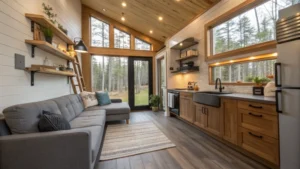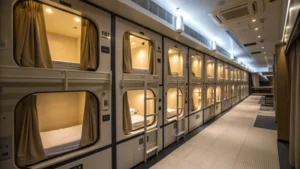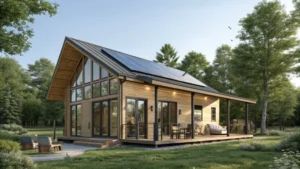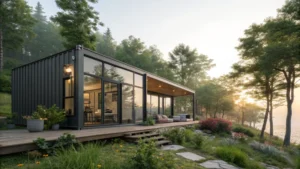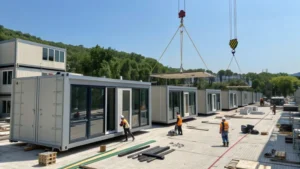
I remember the first time I considered a prefab home and how it opened my eyes to endless possibilities.
The best places to build a prefab home are bustling urban centers with steep land costs, tranquil rural areas with scarce resources, and regions susceptible to natural disasters. Prefab homes offer a smart, cost-effective solution tailored to diverse environments and needs.
Thinking back, I recall standing in a crowded city, wondering how anyone could afford housing here. That's when I realized that prefabs could be the perfect solution. They're ideal for urban areas where space is tight and prices are sky-high. But they also shine in rural spots, where traditional building just isn't feasible due to resource constraints. Prefab homes provide a practical answer, offering efficient and affordable living solutions that adapt to varied surroundings, whether you're dealing with dense cityscapes or remote countryside. Dive into the specifics below to see how these adaptable homes can fit into your plans.
Prefab homes are ideal for urban areas with high land costs.True
They offer efficient use of space and cost savings in expensive areas.
Prefab homes are unsuitable for regions prone to natural disasters.False
They can be designed to withstand harsh conditions, offering resilience.
Why Choose Urban Areas for Prefab Homes?
Have you ever wondered why prefab homes are popping up all over urban landscapes? Well, there's a lot more than meets the eye!
Prefabricated homes in urban areas offer speedy construction, cost efficiency, and versatile design options, making them perfect for cities facing high housing demands and limited land availability.

Rapid Construction in Urban Settings
I remember when I first saw a prefab home being assembled in the city, it was like watching a giant Lego set come to life. The speed at which these homes go up is nothing short of amazing. In bustling urban areas, where every minute counts, this rapid construction is a game-changer. Developers can quickly meet the soaring housing demand with minimal disruption to city life, which is crucial when people are always on the move.
Cost-Effective Solutions
Let's face it, city living can be expensive, and building costs are through the roof due to skyrocketing land prices and labor shortages. Prefab homes offer a refreshing alternative. By manufacturing components off-site, we can significantly cut down on on-site labor and related costs. This makes the whole venture more affordable for urban developers1, who are often juggling tight budgets and high expectations.
Flexible and Modern Design
One of my favorite things about prefab homes is the design flexibility they offer. Urban aesthetics often demand something sleek and modern, and these homes deliver. They can be customized to fit into the unique vibe of any neighborhood while making the most of limited space. Plus, with eco-friendly options becoming more attractive to city dwellers seeking sustainable living solutions2, these homes often come equipped with sustainable features that make them even more appealing.
Adapting to High Demand
The housing demand in cities can be overwhelming. Prefab homes can be swiftly deployed to provide solutions ranging from luxury high-rises to affordable units. This adaptability is a lifesaver for diverse urban populations looking for housing options that suit their varied needs.
Navigating Regulatory Hurdles
Now, let's not forget about the red tape. Urban settings come with their fair share of regulations. Builders need to work hand-in-hand with local authorities to ensure compliance with zoning laws and building codes. Successfully navigating these challenges is not only crucial for project success but also paves the way for smoother future developments through established relationships and an understanding of regulatory knowledge3.
| Benefit | Details |
|---|---|
| Speed | Rapid assembly reduces construction time and city disruption. |
| Cost Efficiency | Lower on-site labor costs make projects more affordable. |
| Design Flexibility | Customizable designs fit urban aesthetics and space constraints. |
| High Demand Adaptation | Quick deployment meets diverse housing needs in growing urban populations. |
| Regulatory Navigation | Essential for project success and future development ease. |
Prefab homes reduce urban construction time by 50%.False
While prefab homes are faster to build, the exact percentage varies.
Prefab homes can lower urban project costs by 30%.True
Off-site manufacturing reduces labor and site-related expenses significantly.
Why Are Rural Locations Perfect for Prefab Construction?
Imagine waking up in a cozy, stylish prefab home surrounded by the serene beauty of rural landscapes. Sounds like a dream, right?
Rural locations are perfect for prefab construction due to lower land costs, easy transportation, and reduced labor needs. Prefab homes fit seamlessly into remote areas, offering a quick and efficient building solution for off-grid living.

Cost Efficiency in Rural Areas
I remember when I first stumbled upon the idea of building a prefab home in a rural area. The cost savings were immediately apparent. Land prices were refreshingly low compared to the eye-watering figures in urban areas. This meant I could afford to put more into high-quality materials and customization, making the place truly my own. Plus, with fewer hands needed on deck for assembly, my wallet breathed a sigh of relief.
| Benefit | Explanation |
|---|---|
| Lower Land Costs | Rural areas offer more affordable land prices, reducing overall project expenses. |
| Reduced Labor Needs | Prefab units require minimal on-site labor, leading to cost savings. |
Ease of Transport and Setup
Another major win for prefab homes in rural settings is their transportability. I often picture those massive trucks rolling through picturesque backroads, delivering my dream home in neat, manageable pieces. The simplicity of assembling these modular structures is a game-changer, especially where traditional methods would struggle without existing infrastructure. It's like adult-sized building blocks but with a much more satisfying end result.
Environmental Benefits
Living sustainably is something I've always aspired to, and prefab homes tick all the right boxes. They are designed with eco-friendly materials and energy-efficient features, which is crucial when you're living closer to nature. In these open rural spaces, there's ample opportunity to harness renewable energy solutions4 like solar panels or wind turbines, making my home not just a retreat but a sustainable haven.
- Sustainable Materials: Many prefab homes incorporate recycled or renewable materials, minimizing environmental impact.
- Energy Efficiency: Designed with energy-saving features, prefab units can operate efficiently in rural climates.
Flexibility and Customization
What really sold me on the idea was the flexibility of design. Prefab homes offer endless customization options, allowing me to create a space that harmonizes with the landscape. Whether it’s a layout that maximizes natural light or finishes that blend with local flora, these homes let your imagination run wild.
Challenges and Considerations
Of course, it’s not all smooth sailing. Setting up a prefab home in a rural area comes with its own set of challenges. Navigating local zoning laws5 can be tricky, and ensuring access to utilities requires careful planning. But for me, the benefits far outweigh these hurdles.
- Zoning Compliance: Understanding local laws is crucial for seamless project approval.
- Infrastructure: Ensuring access to basic utilities can be a hurdle in remote areas.
Embracing prefabricated construction in rural locations is more than just a practical choice; it's a lifestyle decision that combines efficiency, sustainability, and personal expression.
Prefab homes in rural areas lower construction costs.True
Rural land is cheaper, reducing overall construction expenses.
Prefab units require extensive local skilled labor in rural areas.False
Prefab units are designed for minimal on-site labor needs.
How Do Zoning Laws Affect Prefab Home Placement?
Have you ever wondered how zoning laws might affect your dream of placing a prefab home?
Zoning laws determine where you can place prefab homes, impacting land use, property values, and community aesthetics. Complying with these regulations is crucial to avoid legal troubles and optimize home placement.
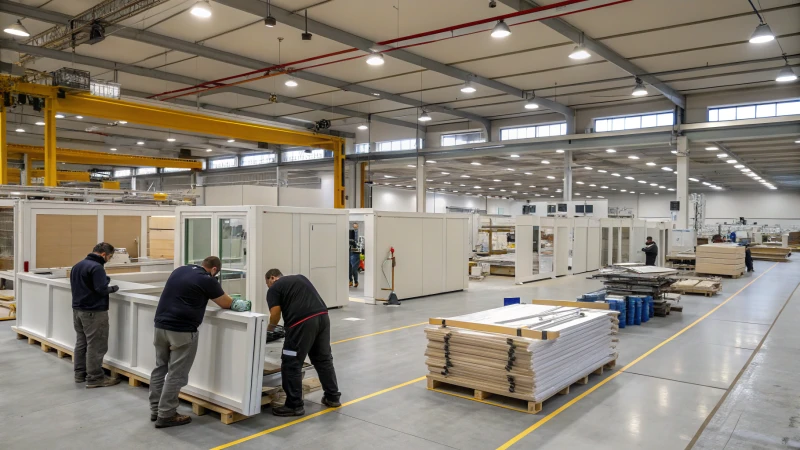
Understanding Zoning Laws and Their Impact
When I first started exploring the world of prefabricated homes, zoning laws seemed like this massive, mysterious hurdle. It felt like the legal equivalent of a labyrinth—one wrong turn, and I'd be stuck trying to unravel a mess of regulations. But the more I learned, the clearer it became: zoning laws are essential because they shape how land is used in our communities, ensuring that development is in harmony with local needs and values.
Imagine being in a residential zone where only single-family homes are allowed. This could potentially limit the placement of larger prefab units, much like when I wanted to bring in a modular home for extra space and realized I'd need to navigate these very restrictions.
Key Factors Influencing Prefab Home Placement
- Land Use Restrictions: These can limit the type and size of prefab structures you can build. I remember having to dig through paperwork to find out if my modular design needed special permits.
- Setback Requirements: Have you ever thought about how far from the street your home needs to be? I once had to rethink my entire layout plan because of these requirements.
- Aesthetic Controls: In some areas, especially those with historic charm or high-end appeal, zoning laws might require specific architectural styles or materials. This was particularly challenging when my design vision clashed with local expectations.
- Utility Access: Ensuring access to water, electricity, and sewage systems is crucial. It's like setting up a new phone; without a signal, it's just a fancy paperweight.
| Factor | Influence on Prefab Homes |
|---|---|
| Land Use Restrictions | Limits on type and size of prefab structures |
| Setback Requirements | Distance requirements from property boundaries |
| Aesthetic Controls | Architectural style and material restrictions |
| Utility Access | Ensures availability of essential services |
Strategies for Navigating Zoning Challenges
- Engage Early with Authorities: One piece of advice I'd give anyone is to make friends with local zoning officials early on. They can offer insights that simplify the process considerably.
- Conduct Thorough Research: Before you get too attached to a plot of land, dive deep into local zoning ordinances6. Trust me; it saves you from unpleasant surprises down the line.
- Seek Professional Guidance: I can't stress enough how consulting with experts like land use attorneys or urban planners can be a game-changer. They have a knack for navigating the complexities I could only scratch the surface of.
By getting to grips with these factors and adopting a strategic approach, both developers and homeowners can successfully integrate prefabricated homes into their communities. This not only enhances your investment but also enriches community life.
Zoning laws are uniform across all regions.False
Zoning laws vary widely across regions, affecting prefab home placement.
Setback requirements can lead to costly modifications.True
Non-compliance with setback requirements may necessitate expensive changes.
What Are the Environmental Benefits of Prefab Homes?
Imagine building a home that not only fits your dreams but also respects Mother Nature.
Prefab homes are eco-friendly because they significantly reduce construction waste, use energy-efficient materials, and lower carbon emissions compared to traditional homes. They offer sustainable living options with minimal environmental impact, making them a smart choice for eco-conscious homeowners.

Reduced Construction Waste
When I first started exploring prefab homes, I was blown away by how efficiently they use materials. Constructed in a factory setting, every piece has a purpose, and there's hardly any waste. I remember visiting a traditional site where piles of discarded wood and metal seemed almost inevitable. In contrast, prefabrication is like cooking with a perfect recipe—everything measured out and nothing left over. This not only saves money but is also a relief knowing we’re not contributing to landfills.
| Construction Method | Material Waste (%) |
|---|---|
| Traditional | 15-30 |
| Prefab | 2-10 |
I’ve seen firsthand how innovative building techniques7 can incorporate recyclable materials, further enhancing this aspect.
Energy Efficiency
In our quest for a greener lifestyle, energy efficiency is crucial. Prefab homes often come with advanced insulation and window systems that maintain the perfect indoor climate. I was always frustrated with how my previous home would either be too hot or too cold, depending on the season. With prefab, it’s like the house has its own thermostat that perfectly balances everything. Plus, integrating solar panels during manufacturing is much easier, making it ideal for sustainable living8.
Lower Carbon Emissions
I was also impressed by how prefab homes manage to keep carbon emissions low. When we built our home, it was a relief to know that components shipped in bulk reduced transportation needs, cutting down the carbon footprint. The streamlined manufacturing process is another bonus; it's designed to be energy-efficient itself. Choosing prefab felt like doing my part in lowering greenhouse gas emissions9, something I believe is crucial in our fight against climate change.
Water Conservation
Living in an area prone to droughts made me appreciate prefab designs even more, especially those with rainwater collection and greywater recycling systems. It's comforting to know that we’re using water wisely and contributing to larger sustainable practices10. It's a small step, but it's vital in preserving our precious resources.
In essence, opting for a prefab home feels like making a pact with the environment—promising minimal waste, improved energy efficiency, and reduced carbon emissions. It’s proof that modern construction can indeed be aligned with sustainability goals. As someone who’s always sought to live sustainably, this choice was a no-brainer.
Prefab homes reduce construction waste to 2-10%.True
Prefab homes optimize material usage, reducing waste significantly compared to traditional methods.
Traditional homes integrate solar panels more easily than prefab.False
Prefab homes integrate solar panels more seamlessly during manufacturing.
Conclusion
Prefab homes are ideal for urban, rural, and disaster-prone areas, offering cost-effective, sustainable solutions with rapid construction and customizable designs to meet diverse housing needs.
-
Explore how prefab homes reduce costs compared to traditional urban construction. ↩
-
Learn about the latest design trends for prefabricated homes in urban areas. ↩
-
Understand the regulatory challenges and solutions for urban prefab projects. ↩
-
Learn about integrating renewable energy sources into prefab homes for enhanced sustainability. ↩
-
Understand the importance of zoning laws and how they affect prefab home construction in rural settings. ↩
-
Researching local zoning ordinances provides insight into legal requirements for prefab home placement. ↩
-
Learn about the efficient material use strategies in prefab home construction that drastically reduce waste. ↩
-
Explore the energy-saving features commonly integrated into prefab homes for sustainable living. ↩
-
Understand the role of prefab homes in reducing transportation needs and emissions. ↩
-
Discover how prefab homes can incorporate water-saving systems like rainwater collection. ↩



